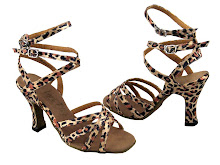In close position, always look over you partners right shoulder. Your right pelvic bone should be inside your partner’s right pelvic bone. This lines up your shoulders parallel to your partner’s, the best position for moving backward and forward. Many ladies have a tendency to keep their right shoulder farther away than their left shoulder. Similarly, men have a tendency to push their partner away with their left hand or pull them too close with their right, with a similar effect. This makes it much harder to move and to lead .
Keep your left arm firm, don’t let it flex. This provides you with a tactile feedback of your partner’s movements. Whether he moves forward or backward, you’ll always keep the same distance from him (see body movement above).
Your right arm should not pull, push or otherwise exert force on you partner’s left hand. Except in certain circumstances, your left arm is used as a decoration. It is not functional.
After a promenade movement, quickly return to a close position and look over his shoulder again. This lines you up again for the next move.
Stay close to your partner and maintain body contact. You’ll feel the direction of his body movements and will be able to react more easily. Relax, don’t be pro-active, don’t try to anticipate the next lead. Don’t be too brittle or strident in your movements, become more languid, letting the man guide you along (don’t fall asleep, though). Try occasionally closing your eyes and concentrate mentally on your partners body movement and his hand, shoulder and head leads.
If your looking for some competitive ballroom dance shoes, then you’ve come to the right place or at least you’ve started in the right place! Check out our website for a wide selection of competitive dance shoes, including ladies, mens, kids, sneakers and boots!
The Dance Shoe Depot.com

Happy Dancing!
via dance tips.






